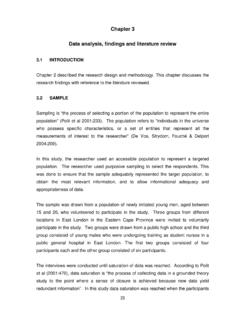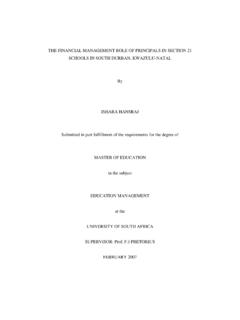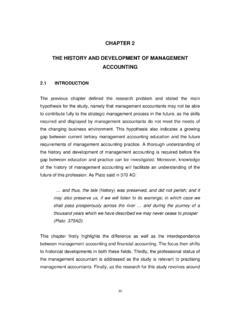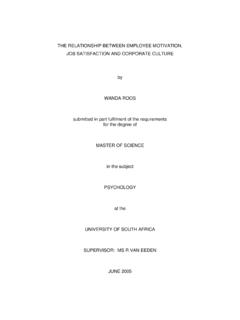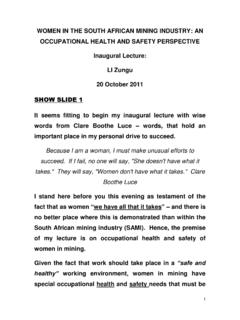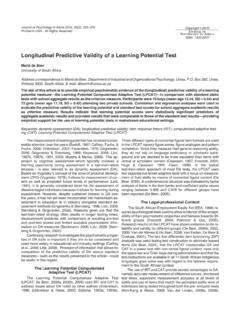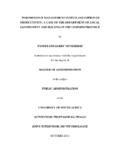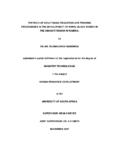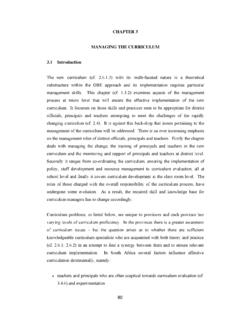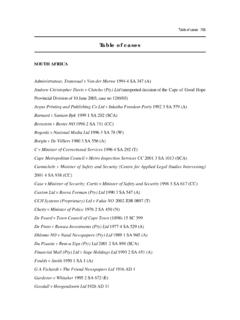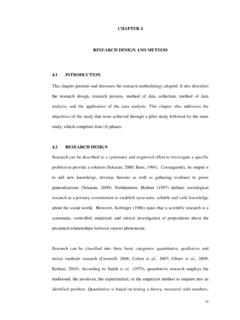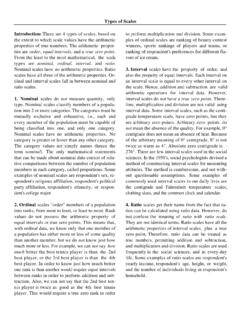Transcription of CHAPTER 7 DATA COLLECTING METHODOLOGY 7.1 …
1 292 CHAPTER 7 DATA COLLECTING choice to undertake any kind of empirical research always presupposes the carefulchoice and design of appropriate research METHODOLOGY . After having studied thetheoretical perspectives on TQM in great detail and formulating a framework for theimplementation of TQM, the results of this process have been used as the basis fordesigning and conducting the empirical research. Moreover, this is done within thesketched context of the aim and functions, as well as the method followed by the SA AirForce to implement TQM as provided in the previous aim of this CHAPTER is to define the method followed for COLLECTING data for theempirical research. Close attention is paid to the method chosen for processing thedata to test the applicability of the suggested total quality framework (as discussed inchapter 3, figure , paragraph ) as a framework for the SA Air Force.
2 The datarequired for the study was collected by means of a structured questionnaire prerequisites for a successful questionnaire are examined, before providing detailsabout the design and development of the questionnaires in question, the contents andthe process of distribution followed in getting them completed. There is a particularfocus in the discussion on reliability analysis and validity, as well as on theconfidentiality of OF DATA COLLECTINGFor the purposes of this study a literature study and empirical research were used fordata collection. When following this method of data COLLECTING , it is essential todistinguish between primary and secondary data. According to Kothari (1985:11)primary data is original information collected for the first time.
3 On the other handsecondary data is information that has been collected previously and that has been putthrough the statistical process. The latter is typically data that has been obtained bymeans of literature studies, as for example those in chapters 2 and 3 of this secondary data for the thesis has been obtained by studying manuals, magazines,journals, dissertations and theses as already discussed in CHAPTER 1, paragraph ,that addresses aspects of quality and achievement, especially in the milieu of service-rendering institutions. As far as primary data is concerned, Drew (1980:11)distinguishes further between experimental and non-experimental research. As thisstudy is clearly of a non-experimental nature, the focus will be on methods of datacollection.
4 Both Drew (1980:12) and Kothari (1985:12) regard questionnaires,interviews and direct observations as the most important means of data COLLECTING . Themeasuring instrument used in this thesis is in the form of a questionnaire . Althoughmore than one type of questionnaire exists, Mulder (1989:39) regard the questionnaireas a data COLLECTING method in general as a purposeful, structured set of questions thatcan be used to obtain the opinions of a large number of respondents in writing, withoutnecessarily making contact with the target group . The reason why questionnaireshave been used as data COLLECTING method in this study will now be discussed in THE questionnaire METHODThe questionnaire method was selected as research method for the thesis as it makesthe quantification of information possible.
5 The reason for using a questionnaire is thatthe opinions of respondents can be obtained in a structured manner. According to VanDyk (1991:278) questionnaires are the most common method applied to diagnose thefunctioning of institutions. Although construing a questionnaire seems to be quitesimple, it is a complex and taxing process. Information (items/questions) must beformulated and selected carefully and the aim of the research must continuously beborne in a quality framework (framework) as the reference framework within which theproblem is researched, as depicted in CHAPTER 3 (paragraph , figure ), ensurescompleteness and demarcation when compiling questionnaires. However, the effectivedevelopment of a reference framework requires an equally important scientific lead thatshould preferably be based on theoretical and empirical research.
6 By using atheoretical framework of TQM, together with empirically based information, a soundbasis is provided for the establishment of a reference framework, unique to the problem294being researched, and the development of a questionnaire with applicable questionsthat are based on the variables contained in the framework (Van Dyk 1991:286).Oppenheim (1978:3) is of the opinion that research is often conducted without thenecessary planning and scientific design of measuring instruments. However, by itsvery nature, a questionnaire as measuring instrument implicitly requires planning and ascientific (1978:4) explains the importance of the research design as follows: Survey design attempts to answer such questions as: Which variables should bemeasured?
7 What kind of sample will be drawn? Are control groups needed? Who willbe questioned, and how often? What scales may have to be built or adapted? VanDyk (1991:273) continues and states that a questionnaire is designed with a specificaim in mind, containing relevant items (questions) to determine the connection, causeor consequence between various aspects/variables in order to determine the current orpotential state of affairs in respect of the uniqueness of the subject being & Hatt (1962:133) define a questionnaire as follows: In general the wordquestionnaire refers to a device for securing answers to questions by using a formwhich the respondent fills in himself. This general definition of a questionnaire concurswith most opinions in this the purposes of this study structured questions were used as these simplify thestatistical process.
8 The degree of structure of questionnaires may vary fromquestionnaire to questionnaire . Structured questions force respondents to choose froma list of alternatives. The potential advantages of structured questions are amongstothers that it is relatively time- and cost-effective, that it facilitates wide geographicalcoverage and that respondents can complete it at their own pace. It thereforesimplifies the collection of relatively more information on a condensed , most respondents are familiar with questionnaires and all are confrontedwith exactly the same questionnaire items. In addition, questionnaire information canbe processed relatively easy as it elicits relatively uniform responses.
9 Computerprocessing is therefore simplified. Questionnaires can also ensure anonymity and as aresult respondents are more inclined to be honest, which usually assists in obtainingmore accurate and valid research information. The chances of the researcher creating295biasness are also lessened as a result of the impersonal nature of obtained in this manner are easily quantified, which make statistical analysisby means of computer possible. It is also more probable that respondents will bewilling to complete this type of questionnaire rather than open questions, owing to thetime and mental exhaustion of the latter. Computer processing of the informationobtained also occurs more quickly and potential disadvantages of a questionnaire with structured questions are therestrictions placed on a respondent.
10 He or she does not have the freedom to moveoutside the boundaries set by the choices. A further disadvantage is thatquestionnaires are commonly used and that low response rates are usually a problemas a degree of resistance to questionnaires exist. Poorly designed questionnairesmay also lead to unsatisfactorily completed questionnaires. There is also no controlover the external circumstances under which the questionnaires are being this reason the design and administration of questionnaires require thoroughness,patience and competence from the researcher. Another potential disadvantage is thatstrongly structured questionnaires can at times make in-depth analysis very difficult. Allinformation obtained by means of questionnaires is also based clearly on verbalconduct, therefore certain scientists regard it as a relatively rigid method with littlespace for personal interaction.
